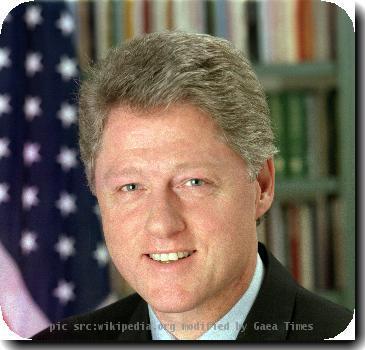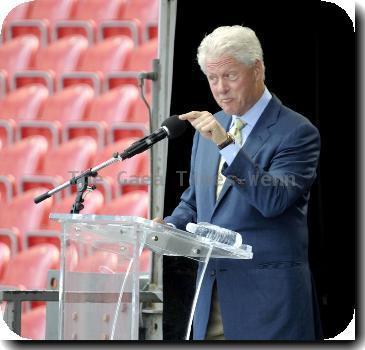Korea, the war without end, casts a long shadow as 60-year mark nears
By Charles J. Hanley, APSaturday, June 19, 2010
Korea, war without end, casts a long shadow
SEOUL, South Korea — Distant thunder rattled the windows as Hong Il-sik, 14-year-old schoolboy, awoke that Sunday. It was the sound of artillery fire, the morning of June 25, 1950, the dawn of a war that never ended.
Looking back, “I couldn’t even have imagined that — 60 years,” says the gray-haired ex-university president.
Gen. Paik Sun-yup, on the contrary, is unsurprised by the endurance of Korea’s endless standoff.
Knowing the enemy, North Korea’s communists, “we sensed back in the 1950s it could be a very long conflict,” the sturdy 90-year-old Paik, a legendary Korean War commander, told a visitor to his memento-filled office above Seoul’s War Memorial, the huge museum he helped build.
The war without end began that long-ago Sunday when North Korea invaded the south to try to reunify the nation, a liberated Japanese colony sliced in two in 1945 by the U.S. and Soviet victors of World War II.
At first, the invaders almost drove a weak South Korean-U.S. force off the peninsula, but U.S. reinforcements poured in, rolled back the northerners and drove deep into North Korea. Then, in late 1950, communist China stepped in, its massed divisions throwing the Americans and South Koreans back to the peninsula’s midsection, where the two sides waged a costly seesaw war over bits of ground for two years, ending with a stalemate, a July 1953 armistice — not a peace, but a war on hold.
The Pusan Perimeter and “Stand or Die.” Walker and Ridgway and Syngman Rhee. The Bowling Alley and the Punchbowl. Unsan-ni and Heartbreak Ridge. Pork Chop Hill and Kunu-ri.
The headline names and places of a lifetime ago fade from memory. But this “forgotten” chapter of 20th-century history still casts a long shadow over today’s world, as the root of unending crises on the peninsula and beyond, and as the war that turned America permanently into a dominant global military power.
The U.S. defense budget, slashed after World War II, quadrupled almost overnight as Washington decided to confront communism militarily. American armed forces ballooned to 3 million men, and U.S. bases spread worldwide. Three months after that June morning in 1950, U.S. President Harry Truman signed National Security Council paper No. 68, saying the nation must, “at whatever cost and sacrifice,” defend democracy “at home or abroad.” Within a few years, the U.S. Vietnam debacle began to unfold in southeast Asia.
It wasn’t only America’s place on the world stage that changed with Korea 1950-53.
“The Korean War thrust China onto the Cold War’s front line,” Shen Zhihua, a leading Chinese scholar of the war, told The Associated Press. “It encouraged Mao Tse-tung to lead Asia’s and even the world’s revolutions,” and it “entrenched the enmity and hatred between China and the U.S.”
The two Koreas, meanwhile, rebuilt industrial economies from the war’s devastation, the north as an authoritarian one-party state obsessed with self-reliance, the south as a capitalist powerhouse under repressive military rule and, for the past two decades, a civilian democracy.
Across the heavily mined armistice line, a 4-kilometer-wide (2.5-mile-wide) demilitarized strip stretching 220 kilometers (135 miles) across the peninsula, almost 2 million troops face each other on ready alert for resumed war, some 27,000 of them U.S. military.
War scares have flared regularly, from the 1968 North Korean seizure of the U.S. Navy spy ship Pueblo, to the long-running duel over North Korea’s nuclear-weapons program, to this year’s sinking of the South Korean warship Cheonan, allegedly by North Korea. The north earned a reputation as an outlaw state through such brazen acts as blowing up a South Korean airliner or kidnapping Japanese men and women,
Why has this state of no war, no peace dragged on for 60 years?
South Korean scholar Hong believes four great powers — the U.S. and Japan on one side, China and Russia on the other — like it this way.
A unified Korea would align with one power or the other, upsetting the regional balance, said the former Korea University president, a prominent conservative commentator.
“By keeping Korea divided, they’re in fact maintaining their own security,” Hong said.
Korea as Cold War victim is a given of history: After the impromptu 1945 division, done for the convenience of the dual military occupation, the U.S.-Soviet superpower rivalry repeatedly foiled all efforts at reunification.
But that Cold War ended a generation ago, and Korea’s cold war goes on.
Historian Park Myung-lim, a prolific chronicler of the war and author of a recent book on its consequences, said the North Korean leadership of the late Kim Il Sung and his son Kim Jong Il bears much of the blame because of its stark black-and-white worldview and bellicose “military first” policies.
Even more, however, it has been a U.S. failure, Park said.
Despite normalizing relations with Moscow, Beijing and Vietnam, the U.S. “has chosen containment over engagement and peaceful coexistence with North Korea,” he said.
“I don’t understand — Washington is much, much bigger and stronger than Pyongyang, but for 60 years they have failed to bring it into the international community, to invite them to the international community.”
It’s because “we’ve never known our enemy,” said the University of Chicago’s Bruce Cumings, whose new book, “The Korean War,” encapsulates a career study of this pivotal 20th-century episode.
American policymakers down the generations wrongly viewed Pyongyang as a puppet of the Kremlin and Beijing, Cumings noted.
“When the Soviet Union collapsed in 1991, these deep suppositions about the nature of the regime led them to predict North Korea would collapse any day soon. Here we are 20 years later and North Korea is still standing,” he said.
Cumings has long advocated for a better understanding of the North Koreans, a people bombed to near-oblivion by the U.S. Air Force in 1950-53. “We burned down every town in North Korea,” U.S. bombing expert Gen. Curtis LeMay said afterward.
“Knowing that, you can understand how North Korea looks at us, the grievances they have,” Cumings said.
Veteran Korea observer Selig A. Harrison, of the Washington research group Center for International Policy, sees “lots of missed opportunities for peace” over six decades of confrontation.
He attests personally to one, when he interviewed Kim Il Sung in 1972 and carried away an offer of a greater opening toward the U.S., only to be rebuffed by American officials.
“Kim Il Sung was a ruthless tyrant internally,” Harrison said. But “he didn’t want another Korean War and he did want normalization with the United States.”
Park Myung-lim said chances for peace slipped by even a half-century ago: “When China withdrew its troops from the north in 1958, this was the proper time for a U.S. troop withdrawal from the Korean peninsula.”
Cumings and others, including Donald Gregg, a former U.S. ambassador to Seoul, cite the abrupt change from President Bill Clinton to President George W. Bush in 2001 as the most recent lost opportunity to end the Korean paralysis.
When Kim Jong Il’s envoy Jo Myung Rok lunched with Clinton officials in October 2000 in Washington, after months of diplomatic groundwork, “I heard things said by both sides that were the most hopeful things ever said since the end of the Korean War,” Gregg recalled.
But incoming President Bush then scrapped the previous administration’s approach and labeled Pyongyang part of an “axis of evil” with Iraq and Iran. “There was total discontinuity,” Gregg said.
Others find fault elsewhere. Hong, a believer in the “collapse” theory, said the biggest recent missed opportunity occurred when South Korea’s late liberal President Kim Dae-jung instituted his “sunshine policy” of peaceful coexistence, economic relations and humanitarian aid for North Korea.
“I strongly believe that in 1998 if Kim Dae-jung hadn’t supported North Korea financially, they would have collapsed by themselves,” Hong said.
Retired Maj. Gen. John K. Singlaub, a former U.S. chief of staff in Korea, sees blown opportunities in the war years themselves.
“The armistice, in essence, rewarded North Korea for invading South Korea. We had the opportunity from a military standpoint. We should have pushed north” — that is, pressed the offensive to subdue the north, said Singlaub, who in 1977 tangled with then-President Jimmy Carter over Carter’s plan, later dropped, to withdraw U.S. troops from the peninsula.
North Korea’s own views on the endless standoff emerge only in uncomplicated official statements, such as a recent one blaming a “background of hostile actions by South Korea and the USA.”
Sixty years of crisis invites such an uncertain array of post-mortems and prescriptions for peace, just as the immediate consequences of the war itself remain uncertain in many ways.
Did 2.5 million people die, or as many as 4 million? The United Nations concluded Chinese military deaths alone reached almost 1 million. The official U.S. death toll stands at 36,516, and hundreds more died from 15 European and other allied nations that came to South Korea’s defense. Tens of thousands were massacred in political executions on both sides. The physical devastation, both north and south, was almost complete: factories and schools, railroads and ports, bridges and dams, and hundreds of thousands of homes destroyed. Some 10 million South Koreans today are separated from family in the north.
For the 49 million South Koreans and 24 million North Koreans, that psychic legacy of the unending war, another kind of damage, remains invisible.
Boston psychologist Ramsay Liem, a Korean-American, tells of an emigre to America who as a schoolboy caught in the war, like Hong Il-sik, saw too much killing. “Happiness leaves the heart,” is how that man described the burden, “and life cannot be lived fully.”
It’s a burden sensed even by younger generations, said Liem, who nonetheless believes that “the North Korean and South Korean people have the capacity to resolve this. The problem is, I don’t think they’ve really had the opportunity.”
From the hillside campus of Yonsei University, historian Park can look out over this throbbing steel-and-glass metropolis, 10 million people all within range of their brother North Koreans’ big artillery. In his crowded office, its document shelves lined with details of the war’s atrocities, Park can relive its horrors.
“The Korean people never imagined they could be separated. That was the beginning of the tragedy,” Park said. “For North Koreans and South Koreans both, the thing now is to avoid a second Korean War at all costs. It would mean the death of all of us.”
Tags: Asia, Beijing, Bill Clinton, China, East Asia, Greater China, Higher Education, Japan, North America, North Korea, Pyongyang, Seoul, South Korea, United States, We

